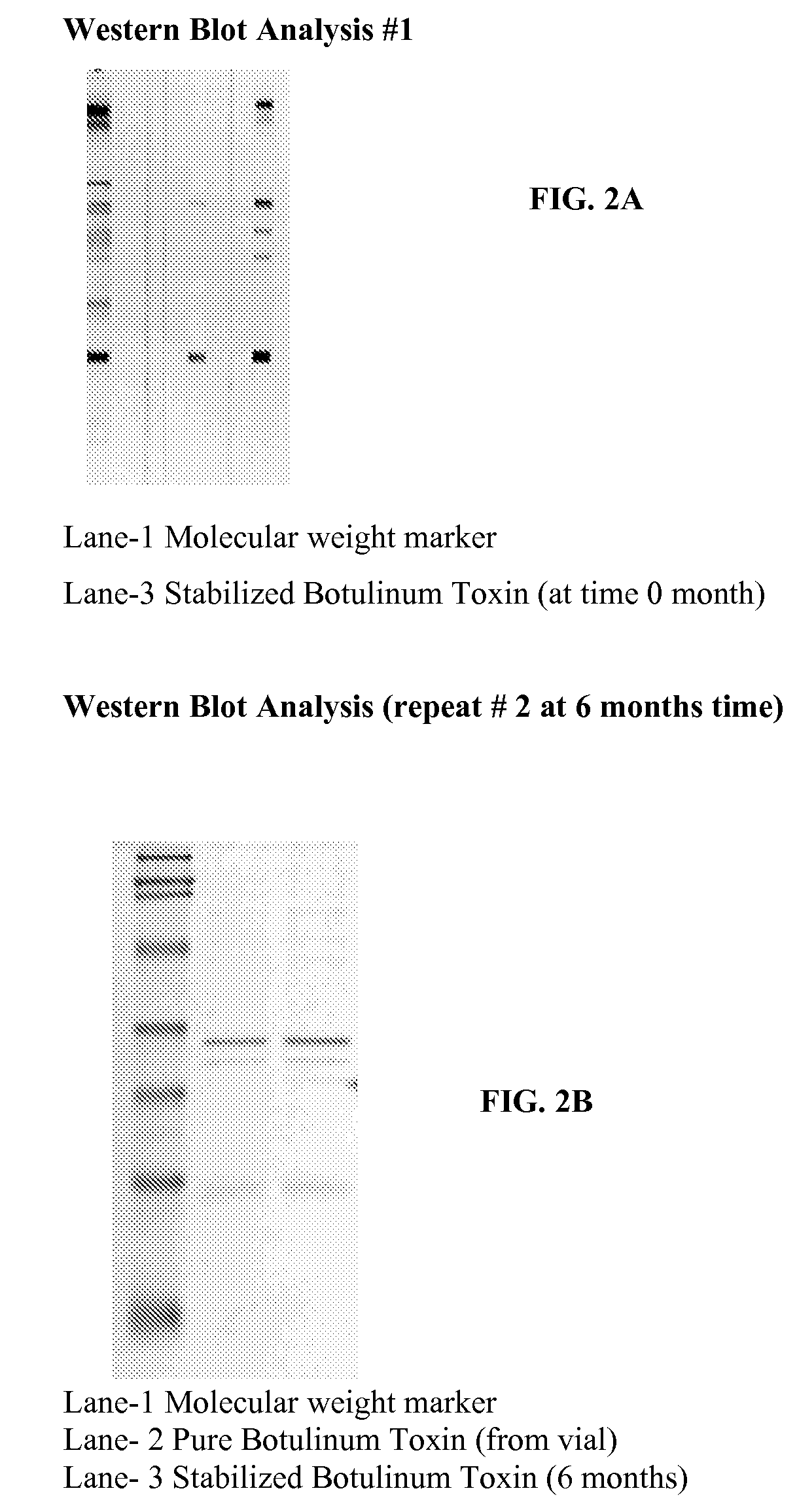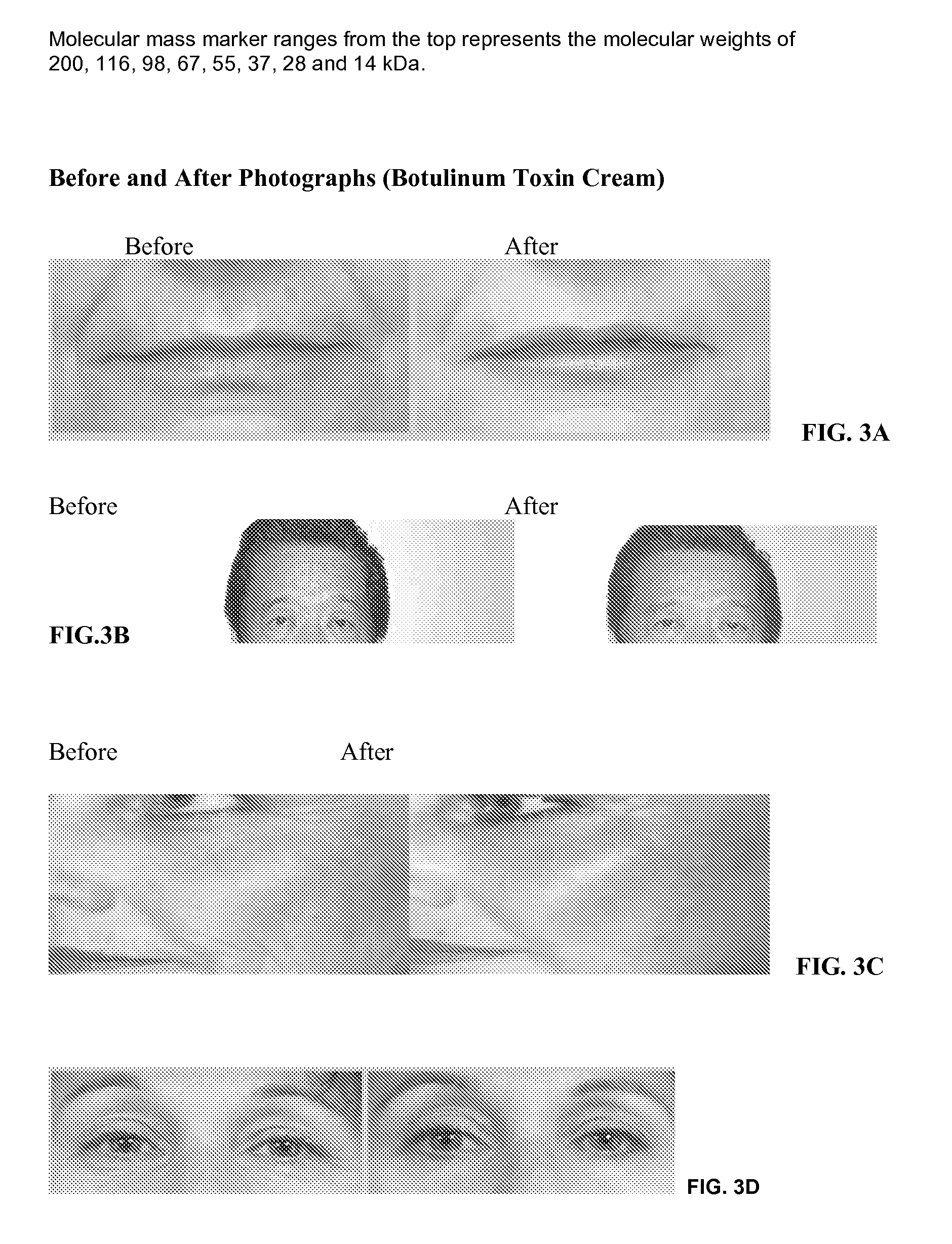Stabilized protein compositions for topical administration and methods of making same
a technology of protein composition and topical administration, which is applied in the direction of antibody medical ingredients, peptides/protein ingredients, peptides, etc., can solve the problems of reducing the total activity of the active ingredient present in the pharmaceutical composition, reducing the total activity of the active ingredient, and reducing the loss of protein and/or protein activity during the formulation. , to achieve the effect of increasing the moisture level of the skin, reducing fine lines and wrinkles, and increasing skin elasticity
- Summary
- Abstract
- Description
- Claims
- Application Information
AI Technical Summary
Benefits of technology
Problems solved by technology
Method used
Image
Examples
example 1
Preparations
[0073]Botulinum toxin (BOTOX® Cosmetic) vials were reconstituted of sterile saline solution (0.9%). The vials were shaken vigorously to dissolve the botulinum toxin (BOTOX® Cosmetic). The reconstituted vials were kept refrigerated and were utilized within 1 hour of reconstitution.
[0074]In a round bottom flask of 50 mL capacity, 10 mg of soluble collagen and 10 mg of Elastin were combined. The mixture was solubilized in 10 mL of sterile saline solution (0.9%) with continuous stirring. In a separate 50 mL round bottom flask, 5 mg of sphingosine and 5 mg cerebroside were combined. This mixture was dissolved in pure ethanol. The alcohol was completely removed by rotary vacuum evaporation to obtain a uniform coating of the sphingosine and cerebroside on the flask wall. To this flask 800 units of botulinum toxin solution in 6 ml of (0.9%) saline was added. The flask was swirled and then stirred continuously for 5 mins at room temperature to uniformly coat the botulinum toxin w...
example 2
SDS-PAGE and Western Blot Analysis
[0075]The stability of the preserved botulinum toxin (Botox) solution was analyzed by standard analytical techniques using SDS-PAGE and Western Blot analysis and HPLC analysis at time zero (few minutes after the preparation of the coated stabilized solution) and thereafter every month in comparison with the uncoated Botox solution.
[0076]SDS-PAGE was performed in all cases under reducing conditions with a BIO-RAD® mini-cell apparatus (Bio-Rad Laboratories, Calif.) with 10% precast tricine gels. The botulinum toxin neat (pure sample diluted with saline) was loaded in one lane as the comparator to the stabilized botulinum toxin which was loaded in the second lane. Both columns were loaded with approximately 100 units of the toxin. The loading buffer, tank buffer, and the molecular weight markers were obtained from Bio-Rad Laboratories. The protein bands were visualized by the Coomassie blue staining technique. Protein concentration (density) from SDS p...
example 3
Cream Formulation
[0078]The stabilized botulinum toxin composition was formulated into a cream for topical administration as outlined below.
[0079]
Total Volume of the cream (400 mL)Phase A:De-ionized Water74.7%Tetra Sodium EDTA0.5-0.7%Methyl Paraben0.2%Propylene Glycol3.0%-4.0%Glycerin3.0%-4.0%Phase B:Cetyl Alcohol (Ado 1 52 NE)2.0%Cetearyl Alcohol2.0%Glyceryl Stearate2.0%PEG-100 Stearate1-2%Stearic Acid (Emersol 132)4.5%Sorbitan Palmitate0.5-0.7%Polysorbate-851.0%Polysorbate 600.5-1%Lanolin Alcohol (Ritachol)1.0%HoHoba Oil0.5-1%Lanolin1-2%Tocopheryl Acetate0.5-1%Dimethicone 2000.7-1.0%BHA0.1%Propylparaben0.1%Diazolidinyl UREA0.2%Phase C:Fragrance (lilac, jasmine)as neededAloe Vera (powder)1.5%-2.0%CoQ-100.5%Retinyl A0.03-0.05%Hyaluronic Acid (pure)1.0-1.5%Talcum Powder (Ti02)1.0-1.5%Phase D:d-limonene0.7%Allantoin0.5%Fulvic Acid0.5%Quillaja saponaria (QTS)0.3%Acanthophyllum squaimsom (ATS)0.3%Myrrh Extract0.2%Hydroquinone Glyquin4.0%Phase E:Stabilized Botulinum Toxin in Collagen Matr...
PUM
| Property | Measurement | Unit |
|---|---|---|
| temperature | aaaaa | aaaaa |
| storage stability | aaaaa | aaaaa |
| temperatures | aaaaa | aaaaa |
Abstract
Description
Claims
Application Information
 Login to View More
Login to View More - R&D
- Intellectual Property
- Life Sciences
- Materials
- Tech Scout
- Unparalleled Data Quality
- Higher Quality Content
- 60% Fewer Hallucinations
Browse by: Latest US Patents, China's latest patents, Technical Efficacy Thesaurus, Application Domain, Technology Topic, Popular Technical Reports.
© 2025 PatSnap. All rights reserved.Legal|Privacy policy|Modern Slavery Act Transparency Statement|Sitemap|About US| Contact US: help@patsnap.com



